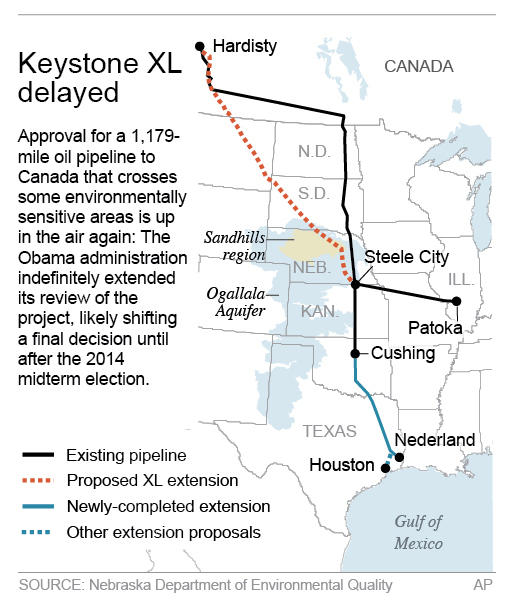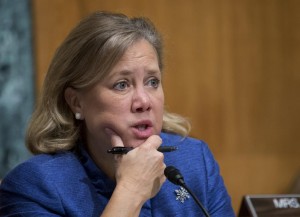redo Jump to...
print Print...
(by Steven Mufson, The Washington Post) – The Obama administration has — again — postponed a decision on the proposed Keystone XL pipeline by giving eight different federal agencies more time to submit their views on whether the pipeline from Canada’s oil sands to the Texas Gulf Coast would serve the national interest. [A decision on the permit was expected in late 2011 but was delayed by President Obama until after the 2012 presidential election, according to the Los Angeles Times. This new delay will take the decision well past this November’s midterm elections.]
 The 90-day period for inter-agency comments was supposed to end May 7, but the State Department extended that deadline, citing “uncertainty” created by a Nebraska Supreme Court ruling that could lead to changes in the pipeline route.
The 90-day period for inter-agency comments was supposed to end May 7, but the State Department extended that deadline, citing “uncertainty” created by a Nebraska Supreme Court ruling that could lead to changes in the pipeline route.
The State Department, which must make the final decision on the permit because the pipeline crosses an international boundary, said it would use the additional time to consider the “unprecedented number” – 2.5 million – of public comments that were submitted by March 7.
“The agency consultation process is not starting over,” the State Department said in a statement. “The process is ongoing, and the Department and relevant agencies are actively continuing their work in assessing the Permit application.”
The move drew sharp condemnation from the pipeline’s supporters, who noted that it was now certain that the pipeline owner, TransCanada, would miss another warm weather construction season.
“Once again, we’re hearing more delays and more uncertainty over the Keystone XL pipeline,” said Sen. Heidi Heitkamp of North Dakota, one of 11 Democratic senators who in an open letter last week urged the Obama administration to approve the pipeline. “It’s absolutely ridiculous that this well-over-five-year-long process is continuing for an undetermined amount of time.”
“This most recent delay leaves everyone waiting in limbo – federal agencies, construction and energy workers and companies, state officials and Canada,” Heitkamp said.

Sen. Mary Landrieu
Sen. Mary Landrieu (D-La.), chairman of the Senate Energy and Natural Resources Committee, vowed to use her position to get the pipeline approved. In a statement, she called the delay “irresponsible, unnecessary and unacceptable.” She also said, “By making it clear that they will not move the process forward until there is a resolution in a lawsuit in Nebraska, the [Obama administration] is sending a signal that the small minority who oppose the pipeline can tie up the process in court forever. There are 42,000 jobs, $20 billion in economic activity and North America’s energy security at stake.”
[Democratic Sen. Mark Pryor (Arkansas) said in a statement “there’s no excuse for another delay.” Democratic Sen. Mark Begich (Alaska) said, “I am frankly appalled at the continued foot-dragging by [the Obama administration] on the Keystone project.”All three of these senators are up for re-election this fall.]
Democratic supporter Terry O’Sullivan, president of the Laborers’ International Union of North America said: “Once again, the [Obama administration] is making a political calculation instead of doing what is right for the country.”
Foes of the pipeline, however, drew encouragement from the delay.
“We believe that the more the facts come to light, whether on disastrous climate impacts or threats to our waters [in Nebraska], it makes us even more confident that President Obama and Secretary of State [John] Kerry will ultimately find that this pipeline is not in America’s interests and must be rejected,” said Tiernan Sittenfeld, senior vice president for government affairs at the League of Conservation Voters [a political advocacy organization that lobbies on environmental issues].
Billionaire Democratic donor Tom Steyer, a California hedge fund founder now campaigning against the pipeline, said the delay was “sensible.” “It’s important to do this right,” Steyer said. “If they feel as if they need more time and more work to understand this fully, then I’m behind them.” [Forbes reports: “Steyer made much of his money at Farallon Capital by investing in fossil fuel producers, before he saw the light and became an anti-carbon crusader. Billionaire oilman Harold Hamm calls Steyer “the world’s biggest hypocrite.'”
The Nebraska court case revolves around a group of landowners who oppose the project. Last year, Nebraska Gov. Dave Heineman (R) backed and signed legislation designed to speed the project by approving TransCanada’s route and letting the company use the power of eminent domain in negotiating right of way for the project. A group of landowners filed suit.
On Feb. 19, the District Court of Lancaster County in Nebraska ruled that the legislature had usurped eminent domain powers that belong to the Nebraska Public Service Commission. The judge, Stephanie Stacy, called the governor’s decision “unconstitutional and void.”
The state attorney general immediately appealed the case to the state Supreme Court. That could take months. If the lower court ruling is upheld, TransCanada would need to obtain a permit from the Nebraska Public Service Commission, which could take up to seven months, according to Jane Kleeb, head of Bold Nebraska and a leading foe of the pipeline. TransCanada also might have to renegotiate rights of way with landowners who might be in a better bargaining position. Kleeb notes that TransCanada’s construction permit in South Dakota expires June 20.
TransCanada chief executive Russ Girling issued a statement saying he was “extremely disappointed and frustrated with yet another delay.”
Girling said that while the Nebraska Supreme Court is considering the case, the law signed by the governor and the existing route were “still valid.” The route, already altered once to largely avoid the state’s ecologically sensitive Sand Hills, also was evaluated by the Nebraska Department of Environmental Quality, Girling noted.
A senior State Department official, speaking on a background conference call with reporters, said, “We are prudently recognizing that the facts that the agencies need to assess could change.”
Girling said that without the pipeline, the United States would buy crude oil from “suspect and aggressive foreign leaders” and import Canadian oil by rail and barge, with more greenhouse gases and spill risks.
“Not building Keystone XL is a lose, lose, lose scenario any way you look at it,” he said.
Reprinted here for educational purposes only. May not be reproduced on other websites without permission from The Washington Post.
Questions
1. a) Why has the Obama administration again postponed a decision on whether to allow the Keystone pipeline to be built from Canada to Nebraska?
b) What does the State Department say it will do with more additional time?
2. The U.S. State Department is the federal executive department responsible for international relations of the United States, equivalent to the foreign ministry of other countries. Why does the State Department have control over the permit for the Keystone pipeline?
3. How many Democratic Senators urged the administration last week to approve the pipeline?
4. What did Democratic Sen. Heidi Heitkamp of North Dakota say about this latest delay?
5. What was Democratic Sen. Mary Landrieu’s reaction to this latest delay?
6. Do you support President Obama’s decision to extend his decision on the Pipeline until after November’s election? Explain your answer.
Background
From an InstituteforEnergyResearch.org post on 9/29/11:
- Three years ago [in 2008], TransCanada proposed the $7 billion Keystone XL pipeline to bring more oil from Canada to the United States. After years of study, the State Department has yet to decide whether or not approve the pipeline. The Keystone XL should be a no-brainer—more jobs and greater access to oil from our closest ally.
- Because the pipeline crosses the border from Canada, the State Department must decide whether the pipeline is in the “national interest.” This should be a simple question. Is it in the “national interest” to get oil from Canada, our largest trading partner and most reliable ally, or should we import more oil from more hostile countries? Even without considering the economic arguments, it should be that simple.
- The economic arguments for the pipeline are also persuasive. The construction of the pipeline alone will create 20,000 jobs. States along the route are projected to receive an additional $5.2 billion in property tax revenue.
From a Bloomberg News editorial posted 9/26/11:
- In deciding whether to allow Keystone XL to run through six American states, the only relevant question is whether it would be safe. The State Department, with help from the Environmental Protection Agency, has studied the risks. It has determined that, as long as TransCanada complies with all laws and regulations, builds Keystone XL properly and operates it safely (although some minor spills would be expected), the pipeline would have “no significant impacts” on wetlands, water supplies or wildlife along its route.
- Keep in mind, the U.S. is crisscrossed by thousands of miles of pipelines carrying crude oil, liquid petroleum and natural gas. One of these is the Keystone 1 pipeline, which already carries crude from the oil sands. Yes, these pipes sometimes leak — spectacularly last year when almost 850,000 gallons of oil spilled from a ruptured pipe in Michigan. Far more often, when leaks occur, they are small and self-contained.
- Pipeline opponents have implied that if the U.S. doesn’t buy Canada’s oil, then companies will be discouraged from developing the oil sands. But it’s unrealistic to assume that the oil couldn’t be sold elsewhere. Yes, today’s business plan calls for sending most of it south — some 700,000 barrels a day through Keystone XL. If the U.S. blocks that conduit, though, we can reasonably expect that another pipeline would be built to Canada’s west coast, where the oil could be sent by tanker to China and elsewhere.
Resources
What do energy pipelines transport? Find the answer at: pipeline101.com/Overview/commodities.html
Read about crude oil pipelines at pipeline101.com/overview/crude-pl.html
For a detailed map of all pipelines in the U.S., click here and scroll down.
Read about Keystone pipeline at instituteforenergyresearch.org/2011/09/29/keystone-xl-more-energy-and-more-jobs
The Los Angeles Times reported in March: “A long-awaited State Department review of the Keystone XL oil pipeline released Friday concludes that the project would have minimal impact on the environment, increasing the chances it could be approved in the coming months.”
(Read more at: studentnewsdaily.com/daily-news-article/keystone-xl-effect-on-environment-seen-as-minimal)
Read a commentary at: nationalreview.com
Daily “Answers” emails are provided for Daily News Articles, Tuesday’s World Events and Friday’s News Quiz.



